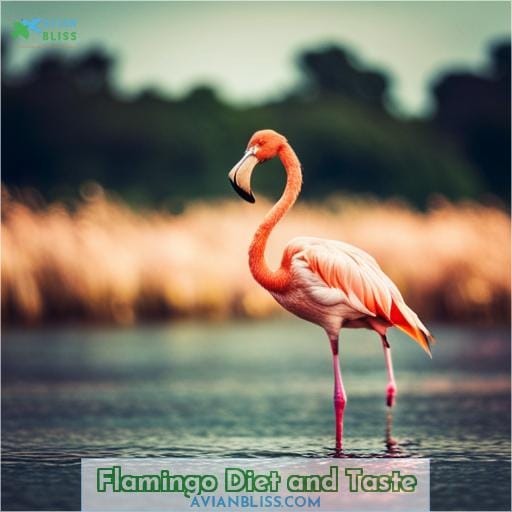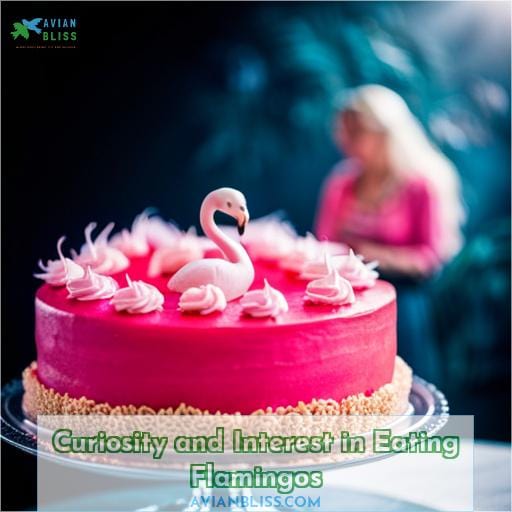This site is supported by our readers. We may earn a commission, at no cost to you, if you purchase through links.
 Amidst the verdant tapestry of life that graces this vibrant planet, there exists a creature both enigmatic and resplendent—the flamingo.
Amidst the verdant tapestry of life that graces this vibrant planet, there exists a creature both enigmatic and resplendent—the flamingo.
Imagine standing at the precipice of a tranquil lagoon, where the sun’s embrace dances upon the waters.
In this ethereal scene, a congregation of these graceful birds unfolds before you, their plumage adorned in hues of mesmerizing pink.
As a seeker of insight into the world’s diverse inhabitants, you harbor an unconscious yearning for connection, dominance, and a sense of place within this intricate ecosystem.
Yet, beyond their captivating appearance lies a culinary curiosity that sparks the wanderings of your mind: Can you consume the essence of the flamingo?
The pages that follow shall unfurl the parchment of history, revealing how these majestic creatures have tantalized the palates of emperors and explorers alike.
Embark on a journey where the past intertwines with the present, exploring the flavors that have graced royal feasts and hidden markets.
Through the eyes of zoologist and observer, you shall traverse the landscapes of taste, tradition, and the delicate dance between preservation and consumption.
Table Of Contents
- Key Takeaways
- Historical Consumption of Flamingos
- Flamingo Diet and Taste
- Cultural and Conservation Aspects
- Legal and Conservation Concerns
- Curiosity and Interest in Eating Flamingos
- Frequently Asked Questions (FAQs)
- What is the nutritional value of flamingo meat?**
- Are there any traditional dishes that include flamingo meat in modern cuisine?**
- How do flamingos contribute to ecotourism in regions where they are found?**
- Do flamingos have any natural predators in the wild?**
- Are there any cultural beliefs or superstitions related to flamingos in different societies?**
- Conclusion
Key Takeaways
- Flamingos were eaten by ancient Romans from the 1st century, using elaborate cooking methods, including tongues.
- Flamingo meat has a gamey taste with a slight fishy flavor due to their diet of algae, crustaceans, insects, and small fish.
- Flamingos have lean muscles for flying long distances, and their meat is rich in protein, Omega-3, and vitamins.
- Flamingos are a protected species with legal penalties for harming them, and conservation efforts focus on habitat protection, research, and sanctuaries.
Historical Consumption of Flamingos
Delving into historical gastronomy, one uncovers the intriguing chapter of ancient Roman culinary practices where Flamingo, with its captivating flame-colored plumage, found its way onto the dining tables.
The Romans’ culinary ingenuity extended to elaborate cooking methods, as evidenced by intricate recipes that celebrated the flavors of Flamingo meat, including its delicate tongue.
Ancient Roman Consumption
Imagine yourself in ancient Rome, where culinary artistry knew no bounds. The Romans, from the first century onwards, indulged in gastronomic extravagance with recipes that transformed the seemingly exotic into delectable dishes, including the tongue of a certain brilliantly feathered bird.
Flamingo, with its mesmerizing plumage, found its way onto their tables. Beyond its visual allure, the delicacy was a testament to their adventurous palate. This culinary curiosity echoed their appreciation for nature’s bounty and embodied their prowess in crafting extraordinary feasts.
Elaborate Cooking Methods
Delve into the culinary history of ancient Rome, where flamingos, known for their vibrant plumage, underwent intricate preparation methods. From braising techniques that transformed their lean muscles into succulent delicacies, to poaching flamingos to retain their unique flavor profile, and even frying methods that added a crispy texture, culinary experiments abounded.
These elaborate cooking methods allowed for creative flavor pairings, showcasing the diverse spectrum of bird flavors in the Roman gastronomic landscape.
Flamingo Diet and Taste
Delving into the dietary preferences of flamingos reveals a fascinating assortment of sustenance, ranging from algae to crustaceans, insects, and small fish. These diverse dietary choices contribute to their notably lean musculature, bestowing upon their meat a distinct gamey essence akin to that of ducks.
Notably, the presence of Omega-3 levels in their food imparts a subtle hint of the aquatic, endowing the flamingo’s flavor profile with a delicate, slightly fishy undertone.
Algae, Crustaceans, Insects, and Small Fish
Feasting on their favored fare, flamingos frequently feed on a feast of algae, crustaceans, insects, and small fish. Their aquatic diet imparts a unique flavor profile to their meat, making it slightly gamey akin to duck, enriched by the omega-3-rich aquatic sources.
This culinary potential, however, collides with their ecological importance; their role in ecosystems extends beyond the plate.
Lean Muscles and Gamey Taste
Exploring their dietary habits further, you might find it intriguing that flamingos’ lean muscles not only contribute to their distinctive gamey taste but also play a role in their remarkable ability to fly over long distances.
This muscle composition lends their meat a unique culinary potential, with flavor profiles that differ from conventional poultry. The meat texture, akin to duck, presents a canvas for various cooking techniques.
However, amidst such culinary considerations, the endangered status of these creatures necessitates stringent legal protection to safeguard their existence.
Omega-3 Levels and Slightly Fishy Taste
As you consider the flavors of this unique avian fare, a subtle hint of the briny deep meets your taste buds, a testament to the Omega-3-rich diet these vibrant creatures indulge in. Culinary potential intertwines with health implications, offering gastronomic experimentation.
The nutritional diversity of flamingo meat, influenced by their omega-3 levels, contributes to a slightly fishy taste. This connection to ancient culinary traditions awakens an adventurous palate, beckoning you to savor a taste that bridges the avian and aquatic realms.
Cultural and Conservation Aspects
Exploring the cultural and conservation aspects of flamingos unveils a complex tapestry that intertwines their nutritional significance. The open markets of China and Thailand conspicuously display flamingo meat, while in pockets of Venezuela and the Caribbean, a covert practice of illegal hunting and consumption persists, casting shadows on the birds’ ecological roles.
These avian marvels, rich in nutrients, remain vital to diverse ecosystems, with some species teetering on the brink of endangerment, urging concerted global endeavors to secure their precarious future.
Nutritional Value of Flamingo Meat
Delving into the realm of nutrition, flamingo meat offers a remarkable blend of nutrients due to its unique diet and habitat. Its lean, gamey flesh boasts flavor profiles reminiscent of duck, enriched by Omega-3 from aquatic sources.
Culinary experiments reveal a mild fishiness, a testament to their diet. Health implications encompass protein, vitamins, and Omega-3 fatty acids. Gastronomic history, entwined with ancient Roman recipes, intersects with ethical considerations of habitat preservation and cultural food preferences.
| Nutrient | Content in Flamingo Meat |
|---|---|
| Protein | Rich source |
| Omega-3 | Abundant supply |
| Vitamins | Nutrient-packed |
| Flavor Profile | Unique gamey taste |
| Ethical Concerns | Conservation prioritized |
In the global journey to protect these majestic birds, understanding their nutritional value becomes vital, connecting human curiosity, culinary traditions, and conservation efforts.
Open Sale of Flamingo Meat in Certain Markets
Witness the unsettling reality as certain markets openly display and trade the vibrant plumage and distinctive features of these magnificent creatures, capitalizing on a demand that jeopardizes the very existence of these majestic beings.
Flamingo meat preparation intertwines culinary traditions, revealing a dichotomy of taste and health implications. Cultural significance fuels consumption, while sustainability challenges and hunting regulations clash with their protected status.
Illegal Hunting and Consumption in Certain Regions
Despite regulations against it, individuals in certain regions continue to hunt and consume the vibrant pink birds, often overlooking the crucial role these creatures play in maintaining the delicate balance of local ecosystems.
- Ecological Implications: Flamingos are keystone species, shaping wetland habitats by filtering water and creating nesting sites.
- Cultural Impact: Ignoring the deeper cultural and ecological significance, consumption perpetuates unsustainable practices.
- Enforcement Challenges: Limited resources hinder authorities from curbing illegal activities effectively.
- Global Conservation Efforts: Collaborative initiatives aim to educate, enforce regulations, and protect these remarkable creatures for future generations.
Ecological Significance and Endangered Status
Exploring their vital role in ecosystems and the precarious status of some species, flamingos contribute significantly to the intricate balance of natural environments. Habitat loss and human impact challenge their existence. Conservation strategies address population trends and IUCN assessments, striving to safeguard these endangered birds.
Legal and Conservation Concerns
Delving into the realm of legal and conservation concerns surrounding flamingos, you’ll find a tapestry of factors intricately woven to safeguard these remarkable avian beings. The Migratory Bird Treaty Act of 1918 stands resolute in its prohibition against the hunting and consumption of flamingos, a defense reinforced by the imperative nature of their communal nesting, historical repercussions on their populations, the weighty penalties for inflicting harm, and the resounding echoes of global endeavors dedicated to their preservation.
Migratory Bird Treaty Act and Illegal Hunting
Delving into the world of legal protection and conservation, the Migratory Bird Treaty Act of 1918 emerges as a pivotal measure. It safeguards vibrant ecosystems, aiming to curtail illegal trade, enforce conservation strategies, and address enforcement challenges.
Beyond legalities, cultural perspectives intertwine with the ecological impact of these majestic creatures. Amid concerns of food crises, exploring ethical and legal ways to consume flamingo meat surfaces, raising questions about cooking methods and preservation of species.
Vulnerability of Flamingos Nesting in Groups
Amidst the marshes and reeds, these elegant birds come together in a vibrant tapestry, forming a living fortress of pink and grace, guarding their precious nests. Nesting dynamics reveal an intricate choreography of survival. Group protection is paramount, as the collective strength shields them from predation risks.
Through this unified stance, breeding success is achieved. Reproductive behavior intricately woven with vulnerability underscores the challenge—history reminds us of past threats.
Historical Impact on Flamingo Populations
Amid the annals of history, the consumption of these vibrant creatures by ancient Romans cast a shadow upon once-flourishing populations of majestic birds.
Historical Significance: The Roman delicacy marked a gastronomic evolution, altering perceptions of these birds from wild to culinary curiosities.
Biodiversity Implications: Gastronomic fascination triggered a demand that reverberated through ecosystems, altering the delicate balance of species.
Feather Trade: Beyond meat, flamingos endured the feather trade’s impact, amplifying their vulnerability in the face of insatiable human appetites.
Culinary Legacy: The history of eating flamingos echoes through time, serving as a reminder of humanity’s influence and igniting a quest for balance in conservation efforts.
Legal Consequences of Harming Flamingos
Explore the realm of consequences that unfold when these majestic birds are harmed – a path that leads to legal ramifications and environmental repercussions.
| Legal Penalties | Conservation Strategies |
|---|---|
| Jail time and fines | Habitat protection |
| for harming flamingos | International cooperation |
Ethical considerations intertwine with the fate of aquatic bird meat. Flamingos, labeled Least Concern for endangerment, demand protection through legal channels. The United States and international cooperation strive to shield these icons, ensuring their place in the wild.
Global Conservation Efforts
In the ongoing mission to protect these magnificent creatures, global initiatives work together, restoring habitats, conducting research, and engaging communities.
Curiosity and Interest in Eating Flamingos
Exploring the realm of online inquiries unveils an intriguing assortment of interests surrounding the edibility of flamingos. These inquiries, stemming from curiosity, children’s literature, zoo encounters, and even the fringes of doomsday prepper culture, reflect the diverse avenues through which humans engage with these captivating avian beings.
Occasional and Diverse Online Searches
Witness the wide array of interests driving inquiries about these vibrant birds. From children’s books and zoo excursions to the intriguing world of doomsday prepper culture, people are captivated by flamingos.
Mythical tales intertwine with culinary experimentation, while flamingo symbolism resonates with artistic inspirations. Even historical banquets where these creatures graced the tables spark curiosity.
This fascination extends to the Andean miners and Iraq’s cuisine, showcasing the manifold realms that ignite flamingo-related quests.
Reasons for Interest (curiosity, Children’s Books, Zoo Visits, Doomsday Prepper Culture)
Delve into the reasons behind this fascination – from a child’s enchantment with storybooks to the intrigue sparked by zoo encounters, even the unexpected allure of doomsday prepper circles, all contributing to the captivating allure surrounding these vibrant creatures.
- Zoo Fascination: Witnessing flamingos in person at zoos ignites wonder about their lifestyle and behavior.
- Culinary Intrigue: The mystery of their taste and historical consumption prompts culinary curiosity.
- Prepper Speculation: In doomsday prepper culture, their potential as a survival resource creates intrigue.
- Educational Value: Flamingos offer a gateway for learning about ecosystems, diets, and conservation.
Frequently Asked Questions (FAQs)
What is the nutritional value of flamingo meat?**
Delve into the nutritional essence of flamingo meat. Rich in protein, Omega-3s, vitamins, and minerals, it offers a taste journey akin to gamey duck, with a hint of the aquatic. Discover its value beyond the plate, shaping ecosystems and conservation efforts.
Are there any traditional dishes that include flamingo meat in modern cuisine?**
Explore modern culinary frontiers and traditions: Few contemporary dishes feature flamingo meat. Conservation concerns, protected status, and ecological importance outweigh any fleeting gustatory curiosity.
How do flamingos contribute to ecotourism in regions where they are found?**
In regions where they are found, flamingos bestow ecotourism with captivating allure. Their vibrant plumage and intricate social behaviors create a tapestry of wonder, anchoring one’s sense of belonging in the wild tapestry.
Do flamingos have any natural predators in the wild?**
Flamingos, graceful waders of vibrant wetlands, elude natural predators due to their unique habitats and group dynamics. Their hue and elegance mirror nature’s balance, invoking a sense of empowerment and harmony in those who appreciate the wild.
Are there any cultural beliefs or superstitions related to flamingos in different societies?**
Explore diverse societies to uncover cultural beliefs tied to flamingos. These revered birds symbolize grace, unity, and spirituality. Their presence offers a sense of belonging, igniting a subconscious yearning for connection and empowerment.
Conclusion
To conclude, the exploration of flamingo meat reveals fascinating insights into its taste, history, and conservation. Did you know that the ancient Romans consumed flamingos as early as the first century? They even had elaborate cooking methods for this unique meat, including the tongue.
Flamingos’ diet of algae, crustaceans, insects, and small fish contributes to their gamey taste, similar to duck. Additionally, their meat has a slightly fishy flavor due to high Omega-3 levels. While some regions still engage in illegal hunting and consumption, global efforts are underway to protect and preserve these magnificent birds.
So, can you eat a flamingo? While it may be tempting, it’s important to prioritize their conservation and admire them in their natural habitats.








